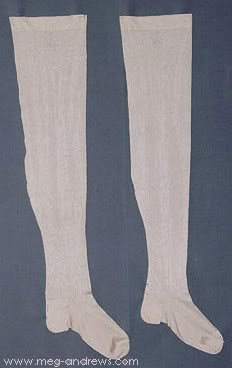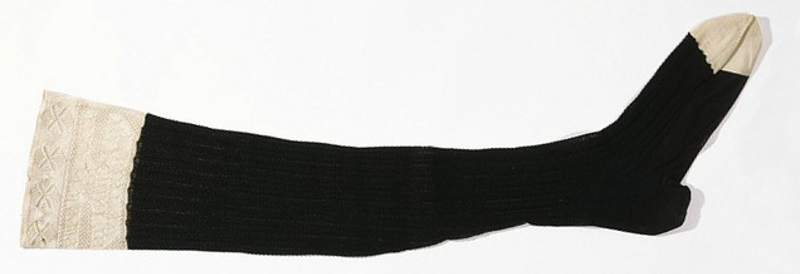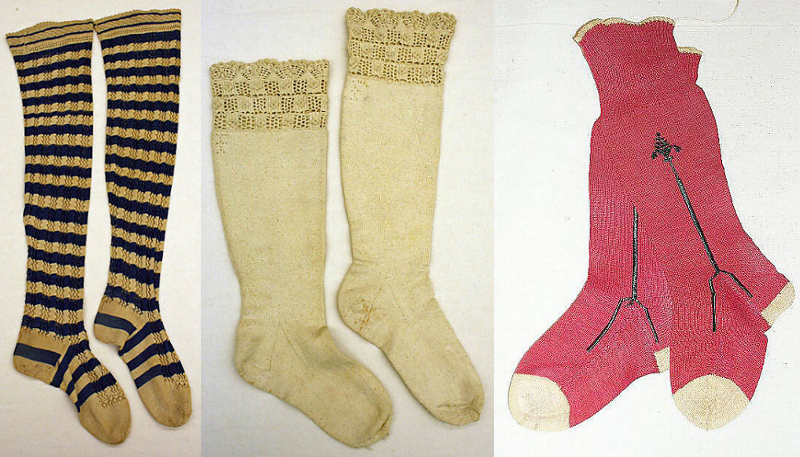We hope you enjoy the articles and short stories presented here, and will join Kate in her adventures for many years to come.
Upon request, you will receive an inscribed copy of Kate Tattersall Adventures in China with every donation of $10 or more plus shipping. Please use the Contact Page to provide your shipping address and we will reply with your total.
Kate Tattersall often referred to hose, stockings and socks. I thought they were all the same thing. Then I came to a passage in which she wrote about wearing hose and socks together. Now I needed clarification. Luckily a friend is a Victorian fashion aficionado. She gave me a complete explanation and provided most of the information for this article. The words hose and stockings were used interchangeably then as now, generally meaning something long, reaching above the knee or to the top of the thigh, while socks were short. (The poor went barefoot, or wore boots with no socks, their feet callused and covered with sores, chilblains in the winter.)
 Only the elite could afford knit silk hose which were, and still are, the luxury item of the hosiery world. Nothing is better than knit silk because it will stretch and breath. Woven silk was less expensive, followed by fine linen, knit wool, then woven wool, and finally cotton. From Kate’s ledger it is clear she had a hosier in St. James that crafted long silk pairs for her legs. She lists her thigh, knee, calf, ankle, and foot measurements for “heavy-weight pure-thread silk hose knit to the required shape.” These would have been knitted with a thin round needle producing tiny stitches and no seam. The colours made note of are white, pink, yellow, and black, but there was every colour available at the time. Top lace trim (known as welts, from the welting stitch in knitting) was listed and seemed to vary in price. This trim was not just a decorative feature, the lace was crafted with greater strength of elasticity to aid in holding the hose up. Knit garters were used, and waist belts and slings/straps. Elastic* garters were also already in use by 1850. (The term suspender belt appeared in the late 1880s, and garter belt wasn’t used until the 20th century.) I have to believe Kate donned these silk hose everyday, always listing them with her outfits, and purchasing dozens of pairs annually, as did any man or woman who could afford them. To the left is a plain light pink pair of Queen Victoria’s silk hose circa 1840s. (Meg Andrews, Antique Costumes and Textiles, is a London based expert who has a fantastic website.)
Only the elite could afford knit silk hose which were, and still are, the luxury item of the hosiery world. Nothing is better than knit silk because it will stretch and breath. Woven silk was less expensive, followed by fine linen, knit wool, then woven wool, and finally cotton. From Kate’s ledger it is clear she had a hosier in St. James that crafted long silk pairs for her legs. She lists her thigh, knee, calf, ankle, and foot measurements for “heavy-weight pure-thread silk hose knit to the required shape.” These would have been knitted with a thin round needle producing tiny stitches and no seam. The colours made note of are white, pink, yellow, and black, but there was every colour available at the time. Top lace trim (known as welts, from the welting stitch in knitting) was listed and seemed to vary in price. This trim was not just a decorative feature, the lace was crafted with greater strength of elasticity to aid in holding the hose up. Knit garters were used, and waist belts and slings/straps. Elastic* garters were also already in use by 1850. (The term suspender belt appeared in the late 1880s, and garter belt wasn’t used until the 20th century.) I have to believe Kate donned these silk hose everyday, always listing them with her outfits, and purchasing dozens of pairs annually, as did any man or woman who could afford them. To the left is a plain light pink pair of Queen Victoria’s silk hose circa 1840s. (Meg Andrews, Antique Costumes and Textiles, is a London based expert who has a fantastic website.)

Silk with lace welts, manufactured by Pope & Plante of London and displayed at the Great Exhibition, 1851, V&A Museum.
Kate acquired her stockings usually from the same hosier, and ordered knit wool made to fit of many bright colours and styles, including patterned and striped. I learned that the stockings were slipped on over the silk.** (Of course when going out to a ball or gala affair she would have just worn hose and dancing shoes, not layers.) These stockings were worn for warmth, but also to protect the silk from the wear of outdoor boots and shoes, and to provide more padding between the flesh and stiff leather. Kate specifically ordered pairs to match her different boots, and the boots were crafted to match various outfits, along with her gloves and hats. Some stockings were embellished with lace and embroidered with silk, gold, and silver thread on the cuffs. They must have been very beautiful and yet always hidden under petticoats and long skirts. It makes me wonder if decorated Christmas stockings are based on such extravagance.

Stockings and socks from the mid 1800s, made of linen, wool, and silk with cotton, from the Metropolitan Museum of Art.
Socks seemed to be a less particular purchase. They were quite inexpensive when compared to other items in Kate Tattersall’s ledger, most of wool, some cashmere. (Silk socks were also made at the time.) She wrote in her diaries about knitting socks on several occasions. Were socks just added for colder weather? Thick socks were made specifically for bed. What could be better than a thick pair of socks inside velvet slippers when rising on a frosty winter day? Her shoemaker crafted custom footwear to fit Kate’s feet, ankles, calves and shins, following every contour, and perhaps her winter boots had room for three of four layers, but that is never specifically referred to. As I quoted in the previous article, layers of socks were definitely worn, The Magazine of Domestic Economy, London 1841, recommending three or more pairs for cold weather. When examining quartermaster lists for general officers on campaign, their silk stockings and wool socks are listed, with funds allotted for both. This is one of those details costumers often get wrong for period pieces, as though people didn’t get cold feet in the past. There is no doubt, those who could afford them wore various layers of hose, stockings, and socks, and often possessed fur-lined winter boots. As an alternative, heavy wool socks were crafted to wear over boots, and the early rubber galoshes were based on this practical solution for cold weather.
Part 2 will cover chemises and camisoles.
*In 1820, Thomas Hancock patented elastic fastenings for gloves, suspenders, shoes and stockings.
** This was the same for men, wearing silk, worsted wool, cotton, or linen, and then heavy wool with their boots.

Gaston Garlovsky
This post made my day. What elegant undergarments they had. Thanks!
Kelle Kimbel
I like this web site very much, so much wonderful information. I’d like silk hose and lace trimmed stockings.
Kredite Bonität
Fine way of describing, and good article to get information regarding my presentation focus, which I am going to present in school.
Christie
Excellent post 🙂
Pilar
Good! Interesting! Thanks!
Analisa
Silk is the way to my heart!
Jade Lauron
Very valuable post for my book research, thank you so much! I really hope to have my little story written in the next couple of months, so if you like fantasy, of course I will hope you check it out! #CallMeBeast
Ela
So informative, thank you a lot.
R.S. Fleming
You’re very welcome, Ela, glad you enjoyed the article.